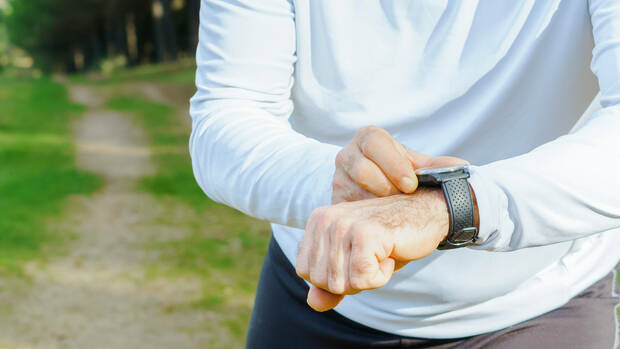Cologne Within a few days, the life of 38-year-old Hermann Müller-Laforet has turned around completely. In November of last year he climbed 3,000 meters in four hours on a mountain bike, he says. After a weekend of hiking with buddies, during which plenty of alcohol flowed, the qualified electrician suddenly felt dizzy. His Apple Watch, which he has worn for years, warned him of an irregular heart rhythm that indicated atrial fibrillation.
After several visits to the doctor, the diagnosis was clear. Müller-Laforet suffers from arrhythmogenic right ventricular cardiomyopathy (ARVC), a rare congenital disease of the heart muscle. “The joy outweighs that I’m still alive,” he says today. Heart muscle diseases are insidious because those affected often do not know about their disease.
Sudden cardiac death is not uncommon. A prominent example is footballer Miklós Fehér from Benfica Lisbon. He suffered from a stiffened heart muscle and collapsed on the field in 2004 at the age of 24. A little later, in the hospital, it was determined that he died of a heart attack.
Heidelberg study with Apple Watch
The Apple Watch can alert people who appear to be healthy about heart problems, or help those who are sick to monitor their heart activity. Benjamin Meder and his team at Heidelberg University Hospital are currently investigating how people with dilated cardiomyopathy – the most common form of heart muscle disease – can use it.
Meder is Professor of Digital Precision Medicine at the University of Heidelberg. “The teaching used to be that those affected should ideally not do any sport at all, because it is known that this can also trigger cardiac arrhythmias,” he says. “We are investigating the extent to which risk avoidance is possible through wearables.”
In dilated cardiomyopathy, the left or right ventricle of the heart widens, preventing the heart from pumping properly. “One in every two hundred suffers from this disease,” says Meder. Young people around 30, who are in the most active phase of their lives, are also affected. “Here it is important to enable an adequate lifestyle.
Müller-Laforet does not take part in the Heidelberg study. He still uses the Apple Watch to check his heart activity. “My first look in the morning is at the clock,” he says. She is a curse and a blessing at the same time. “If the heart rate isn’t right, I’m depressed. Then I put them away for a day and think it has to work without them.”
But he is 90 percent grateful that he can access his heart data via the watch. “It also reminds me to take my medication,” he says.
Apple has certified various heart apps on the watch as medical devices. Other suppliers of smartwatches are Samsung, Huawei or Garmin. They also offer apps for monitoring heart activity.
The Heidelberg university professor Meder has nevertheless opted for the Apple Watch. “It’s a leading product in terms of validation in studies,” he says. “Data security and data protection are also transparent. There are no intermediary servers like many other products.”
Meder and his team developed their own app and transferred it to the Apple Watch. Those affected should use it to explore how much exercise is good for them. The cardiologist, who also taught as a visiting professor at Stanford University, opted for the gold standard of clinical research when designing the study: he is conducting a controlled, randomized study in which the participants are randomly divided into groups.
A group of patients with dilated cardiomyopathy is testing the Heidelberg exercise app. The other group does not use them. At the end, a comparison is made as to whether the app improves the living situation of those affected.
Around 200 patients are already taking part. When 300 patients have completed the program, the study can be completed. Meder expects this to happen at the end of 2024. Initial insights into the data make him feel positive. “The amount of data is immense and promises completely new insights into a disease that is still one of the leading causes of death in young people,” he says.
Apple Watch helps those affected
Handelsblatt asked various self-help groups for heart muscle diseases and held talks with four people affected, including Müller-Laforet. The feedback on the Apple Watch was mostly positive. People with heart muscle diseases use three functions of the watch in particular: pulse control, blood oxygen measurement and ECG recording.
The medical profession also seems to be open to the collected data. Several of those affected report that they had shown abnormal values to the doctors supervising them and that the medication had been changed as a result, among other things. The short battery life of the Apple Watch was criticized.
The Apple Watch’s fall detection is also attractive to respondents. If the wearer faints and falls to the ground, the watch will automatically call 911 after one minute and transmit the coordinates of the current location. The wearer of the watch can store certain data about their illness, such as the medication prescribed, in an “emergency pass”.
The emergency pass is also transmitted in the event of an emergency call. In addition, relatives who are saved as “emergency contacts” will receive a message with the location of the watch wearer.
Müller-Laforet is now considered a risk patient. He recently had a defibrillator (ICD) fitted. This is a matchbox-sized device used to treat life-threatening cardiac arrhythmias.
If the ICD detects an abnormal heart rhythm, it can deliver an electric shock to get the heart back to its normal rhythm. “When I’m sitting on the sofa in the evening, I sometimes notice that he’s helping out,” says Müller-Laforet. “Then it pinches. But I don’t notice it in everyday life.”
This text was published on March 27th, 2023 in the Handelsblatt newsletter Inside Digital Health.
More: Dermatologist Afshin Fatemi uses a hair robot for hair transplantation
